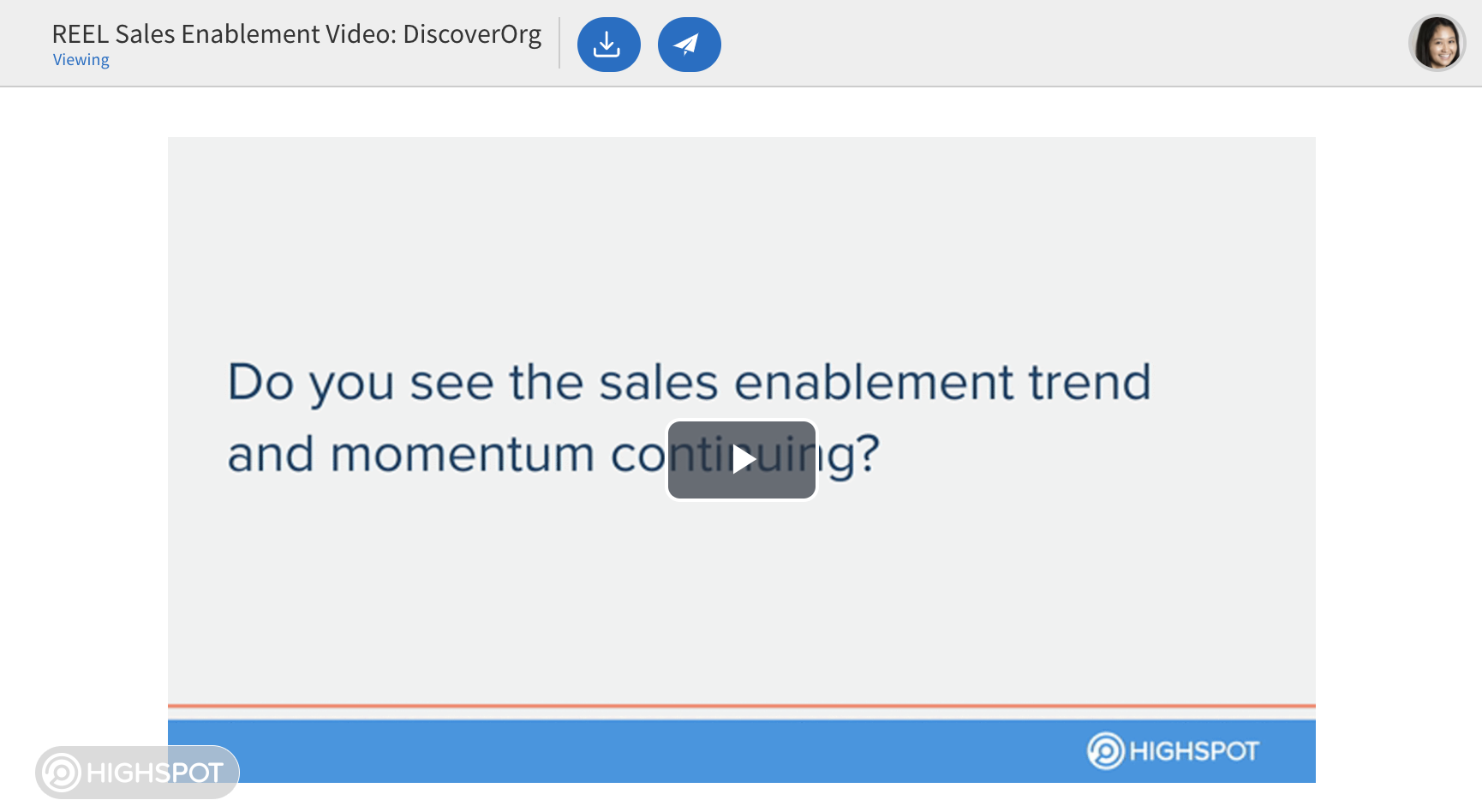I always find it fun to interview fellow marketers and bond through our shared understanding of great products, strong value propositions — and common pain points. The pain of sales and marketing alignment (or misalignment) is one that every marketer knows but few know how to solve. After trying to tackle this issue in several different ways, Phill Sundal at DiscoverOrg finally found success with Highspot. In the interview below, he outlines the successes and failures he encountered as he worked to bring sales and marketing into alignment at his company.
Here is the video interview, as well as the interview transcript, below:
Interview Transcript:
Cassandra: Hi, Phill! I’d love to have you provide insights on why you see the sales enablement trend and momentum continuing in the market.
Phill: The momentum in sales enablement that we’re seeing today is largely due to advancement in technology. Technology is giving us extra visibility into not only who our buyers are but what their buyer journey looks like. Through the use of technology and the ability to integrate data into different sales and marketing tools, our sellers can better align with touchpoints in real time.
We’re seeing this mass adoption of sales enablement technology right now because they prove their value. Sales enablement is giving back time to reps and allowing reps to add more value to buyers in a more streamlined process, and the results of that are more revenue.
Cassandra: Why is sales enablement an important investment for companies today?
Phill: If you are not prioritizing your accounts, if you are not prioritizing your outreach, if you’re not basically optimizing every single touchpoint—your competitors are going to come in and do it for you. A lot of deals are won based on who can be the first to table and add the most value. Sales enablement tools enable reps to get that value and share that value in a more effective way, quicker and at the right time.
Cassandra: What are your top sales enablement initiatives?
Phill: What’s big for us right now in sales enablement is coaching. Keeping track of the skill levels of all of our various reps. It was easy when we had 10 different reps, but now with several hundred reps, it’s hard to keep track of where everyone’s skills are and where they might need help. We’re really focusing on building up a pyramid or rubric of success where we can track reps’ comfort and ability in selling different products or talking to different buyer personas. Then, we’re tracking that over time so we can be sure that we’re continuously educating and ensuring that reps are as prepared as possible.
Cassandra: How does your team currently measure sales enablement success?
Phill: Sales enablement is typically tied to retention on the customer side, length of sales cycle on the sales side, and the average sales price. If reps are armed with everything they need for the sale, if they have all the data they need to multithread the account, it’s likely that they are going to convey the message in a clearer way. It’s likely that they’re going to shorten the sales cycle, because they are not going to single-thread, and they have all the contact they need. It’s likely through pitching the multiple contacts at the right time, and adding the right value and messaging, that you’re going to get a larger spend from your customers. We look at all three of those metrics to determine success.
Cassandra: What did your sales process look like before implementing Highspot?
Phill: It was disjointed and there was a lot of guessing. What our investment in Highspot has done was give us data around what our sellers are actually doing, what content they are actually using. It wasn’t “spray and pray,” but we weren’t as methodical about who our reps reached out to and how our reps engaged and the timing of their engagement. For example, Highspot has enabled us to reach out to prospects at the moment that they are viewing the content, at the moment in which it is top of mind. And so, our conversion rates in booking those demos and closing those deals has increased because of Highspot.
Cassandra: What are the top ways that Highspot has helped you?
Phill: Highspot has given us back time. Before Highspot, we had a lot of content in multiple repositories, and there was a problem with version control. Reps, just for their own ease of use, would have their four or five pieces of go-to content that they would keep on their hard drive to use. Now that we’ve put all content in one place, and we’ve eliminated version control issues, reps now trust the content and they have one place where they’re getting their content. That enabled reps to use more of the content, and use a larger diversity of our content, improving our return on content investments.
Cassandra: How has Highspot helped reshape your sales enablement strategy?
Phill: With Highspot data, we now know how our customers are engaging with different pieces of content. We’ve been able to map out all of the different content that the buyer should see, specific to their persona or industry, and all of the touchpoints along the way. Now, we have more strategic cadences of content that we’re sharing throughout the sales cycle rather than just sending a random follow-up deck or data sheet. It’s much more methodical.
Cassandra: How did you end up choosing Highspot?
Phill: I chose Highspot because my reps loved it. I spent a lot of time putting a lot of different tools in their hands. Highspot was the clear choice. To start, the search is incredibly powerful. Reps don’t want to put in the time to learn a new taxonomy or have to memorize the names of certain files. So being able to quickly, easily, and reliably search by persona, issue, topic, or industry makes their lives so much easier. In fact, I challenge them to try to break the search all of the time. What it does is expose them to all of the relevant content in a very quick manner.
Cassandra: What is your favorite Highspot feature?
Phill: As a content manager and content creator, I really enjoy Highspot’s approach to organizing content. Part of the challenge for us, when we’re looking at content, is — again, reps won’t remember the names of all of these pieces of content—- our reps want to be able to say, “Show me all the content for this buyer persona in this industry and this company size.” The Highspot taxonomy allows me to organize my content flexibly across the segments that are specific to our business. Now, our reps don’t have to think about what specific piece they should be sending — they can simply select the problem, the solution, and the customer persona, and then be presented with different content options that fit that criteria.
My second favorite feature would be the real-time engagement alerts. Being able to follow up with prospects at the time that they are viewing the content or seeing who they’ve shared that content with has helped us identify who the decision makers are within the account quickly. It has helped us plan our follow-up during times when it’s more relevant to the buyer.
Cassandra: What results have you achieved with Highspot?
Phill: Our reps are adamant that it saves them time. And that’s time that they can then spend to set that one extra meeting or do that one last demo. Previously, they’d have to spend 15 to 20 minutes putting together content or a follow-up email. That’s now automated so they can repurpose that time for more valuable activities.
Cassandra: What advice would you give to new sales enablement practitioners?
Phill: If you are going to invest in a sales enablement platform, first make sure that you understand what the day-to-day looks like for your reps — where they are actually spending their time. Are they in Salesforce? Are they in email? Are they in a different platform? Ensure that whatever tool you’re going to invest in can live where they live. The last thing you want to do is give them another place to have to reference or another tool to have to log in to. Ensure the sales enablement tool integrates into their already-established workflow. You will have much better adoption.
Secondly, find the biggest pain points for your reps. Whether it’s finding content, understanding content engagement, or time spent putting together content, make sure that whatever tool you’re investing in has a focus on that area, because there’s a diversity of different tools and offerings to solve these different problems.



